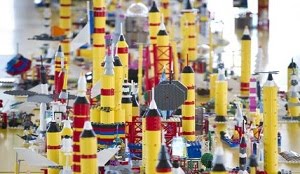The US space agency, hoping to send astronauts to Earth's natural satellite by 2020 for the first visit since 1972, announced it is on course to launch the dual LRO and LCROSS missions atop an Atlas V rocket from Florida's Kennedy Space Center.
A day after scrubbing the shuttle Endeavour launch for the second time in a week because of a nagging hydrogen fuel leak, NASA said it has three launch windows ready at 5:12 pm (2112 GMT), 5:22 pm (2122 GMT) and 5:32 pm (2132 GMT).
If none work out, officials have inked in three more opportunities late Friday.
The mission is the first step on the long haul journey to launch explorations further into our solar system, to the planet Mars and beyond.
"The robotic mission will give us information we need to make informed decisions about any future human presence on the moon," program manager Todd May told reporters earlier this week.
The Lunar Crater Observation and Sensing Satellite (LCROSS) in particular looks set to be one of NASA's most spectacular bids at discovery for years.
To seek out water ice on the moon -- a critical component for any planning for manned lunar colonies -- the probe will analyze data from ejected lunar material after the separated Centaur rocket crashes into a permanently shadowed crater, on the dark side of the moon that never sees sunshine.
After examining the moon matter, the kamikaze explorer will follow the rocket's lead by also hurling itself into the moon at approximately 1.55 miles per second (2.5 kilometers per second) -- some 5,580 mph (9,000 km/h).
In total, NASA said, the two impacts will excavate some 500 metric tons of lunar material and begin the search for signs of a possible long-frozen water source and examination of the unseen world's mineral makeup.
The Lunar Reconnaissance Orbiter, or LRO, hopes to push forward the space effort's knowledge base through a one-year stay at an orbit of about 31 miles (50 kilometers) -- the closest any spacecraft has continually orbited the moon.
LRO's 500-million-dollar mission is designed to provide NASA with maps of unprecedented accuracy, which will be crucial for scoping out possible landing sites.
Both missions, May said, will help NASA model the nuances of lunar lighting and temperature range, and provide future moon travelers with information on the cosmic radiation the moon is exposed to due to its lack of atmosphere.
The probes' four-day, 238,000 mile (384,000 km) return to the moon 40 years after humans first set foot on its surface is expected to illuminate our closest extra-terrestrial neighbor like never before.
Both LRO and LCROSS missions, May said, promise to teach the long distance explorers "the process that formed the earth, the moon and the solar system."
The agency hopes the probes will answer a full plate of fundamental questions of cosmic history.
"Earth is subject to erosion processes from air and water," noted May. "The moon itself doesn't have this process... LRO will send back pictures daily on things we have barely seen before."
Hopes for the ambitious exploration of the moon and later Mars were dampened Wednesday by Senator Bill Nelson, who warned of grounded missions because of "unrealistic" funds allocated to NASA.
Nelson, a former space shuttle astronaut, told the first public meeting of the Review of US Human Space Flight Plans Committee in Washington that "NASA simply can't do the job it's been given" to return to the moon.
Inadequate funding, he said, "has led us to the point where we are now: with a space shuttle that's going to shut down but without the new rocket developed in time to pick up where the shuttle leaves off."
When President Barack Obama unveiled the federal budget last month, he ordered a review of the problem-plagued, budget-busting rocket that NASA hopes will be on launch pads by 2015 to replace its shuttle fleet, due to be retired next year.
The cost of the next-generation rocket has ballooned from an initial 28 billion dollars to about 44 billion due to technical troubles and cost overruns.





0 comments:
Post a Comment